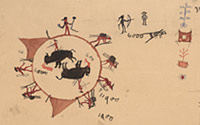History 3010 American Indian History
Spring 2012 Course Calendar - subject to change with notification
A "winter count" was a Native American mnemonic device passed from one generation to another marked with pictographs that recorded noteworthy events in tribal life that took place each "winter" or year. Battiste Good, a Brulé Dakota living at the Rosebud Agency in South Dakota, probably made this winter count at the turn of the twentieth century based on original records kept on hides (he introduced Arabic numerals). Special characters denoted famines, the introduction of the horse, buffalo hunts, severe winter storms, smallpox epidemics, and other significant events. (Source: http://www.loc.gov/exhibits/treasures/trm054.html)
| Week | Readings | Activities |
|
One - Introductions |
|
|
|||
|
Two - Origins |
|
Oral Presentation #1: research a site in
Indian Country which existed prior to 1492. Prepare handout and
present findings orally.
Response paper #1: Use the readings to answer the question Mann asks the scholars: Where would you have rather lived in 1491, Europe or the Americas? (draft for peer review due January 23; final draft due January 30) |
|||
|
Three - Middle Ground |
|
|
|||
|
Four - Five - Encounters |
|
|
|
Six |
|
Response paper #2 Use the readings and
other materials to explain: Native Americans during the colonial
period are sometimes characterized as victims who succumbed to
more powerful Europeans. Do you agree with this
characterization? Be specific about strategies used by Natives.
(peer review due: February 10, final draft due: February 17) Oral presentation #2: documents in Calloway and additional
|
||||
|
Seven - Losses |
|
|
||||
|
Eight - Holding the West |
|
Exam 1 available on chi tester February 24-27 |
||||
|
Nine - Americanization |
|
Response paper #3: With Indians confined on reservations, attempts by reformers and government officials to transform and assimilate Native people took new forms. Particularly devastating were renewed efforts to impose private property, new work regimens, different gender systems, the English language, and Christianity on American Indians. This social engineering-cultural, social, and economic colonialism-had a devastating impact, not only on Native societies and cultures, but materially on the larger Indian land base, as millions of acres were lost to Native people in the years following the General Allotment Act (or Dawes Act) of 1887. Indians themselves forged new ways to accommodate and resist this colonialism-including new pan-Indian organizations and prophetic movements-but the situation often proved grim during these late 19th-, early 20th-century years. Focus on one of these policies: allotments, boarding schools, denial of religious practices, leadership change. Describe and comment. (draft due March 9; final due March 19) |
||||
|
Ten - Self-Determination |
For up to 5 extra points, attend either the symposium of the Pow Wow. Write a short paper: description and response. (due: March 19) |
oral presentation #3:
Research a treaty between the U.S. and a
particular Indian nation. Also research
how that treaty figured in claims against the U.S. in
the 20th century.
|
SPRING BREAK
| Eleven - Twelve
|
|
Response paper #4 : Duthu’s sympathies are clear: he dismisses critics of special tribal rights as ignorant and castigates infringements of tribal sovereignty as motivated by neocolonialist views of Indians as a “dying race.” How has he made a compelling case for the necessity of such sovereignty and tribal rights? Focus on one issue -- stewardship of land, economic development, etc.(draft due: April 4; final due: April 11) |
||||
| Thirteen
|
Response paper #5: "Native Americans have not died out ' like snow before the sun,' nor have they 'vanished' into the melting pot of 'civilization.'" Using class materials, describe how you have come to an understanding that Indians exist in these times and that knowing about American Indians helps us know about all of us. In other words--how are you getting to Indian Country? (due: April 16) |
|||||
| Fourteen |
|
|||||
| Fifteen |
|
|

